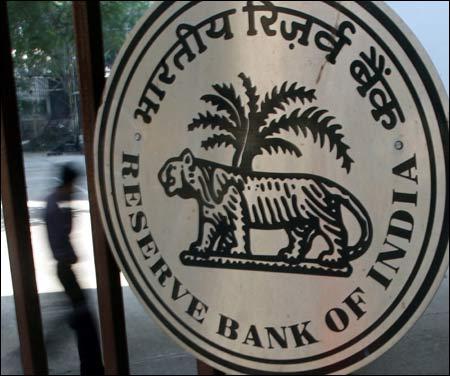Photographs: Rediff Archives Salil Dhawan, Investment-mantra.in
Why the banking sector is so very important for the economy, its performance in the year 2011, key challenges in the year 2012 and why it can be a turnaround story in the year 2012.
Why banking / financial sector is so very significant for any economy, especially India?
An efficient banking system caters to the needs of high-end investors by making available high amounts of capital for big projects in the industrial, infrastructure and service sectors and thus driving country's growth. At the same time, they also make credit available to the medium and small businesses for new investment and expansion of the existing units. Rural sector in a country like India can grow only if cheaper credit is available to the farmers for their short and medium term needs.
Credit availability for infrastructure sector is also extremely important, especially in a developing economy such as India. The success of any financial system can be fathomed by finding out the availability of reliable and adequate credit for infrastructure projects. Fortunately, during the past decade there has been an increased participation of the private sector in infrastructure projects in India. The banks and the financial institutions also cater to another important need of the society i.e. mopping up small savings at reasonable rates with several options.
The common man has the option to park his savings under a few alternatives, including the small savings schemes introduced by the government from time to time and in bank deposits in the form of savings accounts, recurring deposits and time deposits.
Courtesy: Investment-mantra.in
Disclaimer: This article is for information purpose only. This article and information do not constitute a distribution, an endorsement, an investment advice, an offer to buy or sell or the solicitation of an offer to buy or sell any securities/schemes or any other financial products /investment products mentioned in this article or an attempt to influence the opinion or behavior of the investors /recipients.
Any use of the information /any investment and investment related decisions of the investors/recipients are at their sole discretion and risk.
Why you should BUY bank stocks in 2012
Photographs: Rediff Archives
2011 and the Indian banking sector
The year 2011 was quite challenging for the banking sector on a whole in which the country's largest bank, State Bank of India, or SBI, came under Moody's scanner. The rating agency downgraded its perpetual bond ratings by a notch. The downgrade indicated that India's banking sector was not in the best of health. There were growing concerns on deteriorating asset quality, capital challenges and issues such as financial inclusion as 50 per cent of the Indian population has no access to banking.
If you look into some key statistics, India's largest private sector lender ICICI Bank's market capitalisation plunged 23 per cent to Rs 96,165 crore since the beginning of the second quarter (July-September 2011). This was the highest erosion among top six banks in nearly last two months.
Meanwhile, India's largest bank, state-owned State Bank of India's market cap fell by 17 per cent to Rs 1,24,801 crore during the same period. This is 6 per cent less than that of its private sector peer ICICI Bank market cap loss.
The second largest PSU lender Punjab National Bank's market cap dropped around 11 per cent to Rs 30,407 crore. The fall is marginally (around 1 per cent) higher than its private sector peer HDFC Bank, which fell by 10 per cent to Rs 1,03,894 crore.
Axis Bank, the third largest private sector lender, sank 21 per cent to Rs 42,113 crore. This was higher in comparison to the third largest PSU lender, Bank of Baroda's market cap that slipped 18 per cent to Rs 28,130 crore.
Why you should BUY bank stocks in 2012
Photographs: Rediff Archives
Banking sector's performance in 2011
2010 and 2011 has been a difficult period for the global banking system, with challenges arising from the global financial system, Eurozone trouble as well as the emerging fiscal and economic growth scenarios across countries.
The asset quality of PSU banks faced more deterioration in 2011 compared to 2009 and that reflected in higher non-performing assets in 2011 compared to 2009. Private banks look relatively better placed on this front. PSU banks, given their loan profile, margin track record and inferior asset quality are more disadvantageously placed as compared to private banks.
With GDP growth decelerating faster than expected, annual credit growth guidance of many PSU banks is at risk. A further tightening of liquidity would be a negative both from margin and growth perspective though it is expected that RBI may take up measures to loosen the liquidity scenario. Traditionally, PSU banks have shown more operating vulnerability than private banks during periods of high liquidity deficit.
The reasons besides the weak macro-economic have been low capital adequacy, high interest rates and fear of increasing NPAs. Banking shares were also under pressure after global credit rating agency Moody's Investor Service cut the standalone rating of India's largest public sector bank, SBI in October 2011 due to concerns over capital and rapid deterioration in asset quality. The agency cut its rating on SBI's financial strength to D+ from C- and lowered its hybrid debt rating on the bank to Ba3 from Ba2, following the reduction in financial strength rating.
The repo rate, the rate at which banks borrow from the RBI for short duration, was increased by 3.75 per cent between March 2010 and September 2011 to control inflation. In this rising interest rate scenario, the net interest margin (NIM), an indicator of a bank's operational efficiencies, of nationalised banks, which account for 74 per cent of the assets of the banking system, increased from 2.63 per cent in March 2010 to 3.2 per cent in March 2011.
However, in the period between March and June 2011 when interest rates have continued to rise, the NIMs of nationalised banks shrunk to 2.9 per cent.
Why you should BUY bank stocks in 2012
Photographs: Rediff Archives
Banking sector outlook for 2012
At the start of the year 2012, the Bank Nifty at a two-year low leaves a possibility of strong recovery in the near future. The outcomes deduced in the current scenario are that the worst is over for most banking stocks and its time to buy. The worst of inflation pressure is over, interest rates have peaked and stock prices have reached value zone and in some cases are at historic low.
As far as capital adequacy is concerned quite a few PSU banks are in urgent need to raise capital (including SBI), but poor government finances means that this could not be done so far. Government has recently announced a capital infusion to the tune of Rs 6,000 crore in SBI via preferential issue by the end of March 2012 which should improve its capital adequacy ratio (total recapitalisation requirement is now up to Rs 17,000 crore vs originally budgeted Rs 6,000 crore resulting in a supplementary demand).
Union Bank, IDBI Bank and Syndicate Bank are some other banks that may get capital infusion this fiscal. With the global banking system shifting from Basel II to Basel III to further strengthen risk management framework, Indian banks will need to raise additional capital to meet the stipulated requirements.
The planning commission has approved Rs 140 billion recapitalisation plans for PSBs in FY12 but this may get postponed due to lack of finances. This also creates an overhang on the stock prices. Most of the PSU banks got capital support from the government during the last fiscal. These banks included Punjab National Bank, Bank of Baroda, Union Bank of India, UCO Bank, Allahabad Bank and Andhra Bank among others.
Bad times for the economy could mean lower credit growth. If we were to look at overall economy scenarios between these two periods we feel that credit growth could weaken going forward in FY12 closer to 11-12 per cent vs the current 15-17 per cent.
Why you should BUY bank stocks in 2012
Photographs: Rediff Archives
Conclusion
Even if RBI announces interest rate cuts, as is anticipated in the near term, the relief expected could take some time to factor. Banks and financial intuitions have played major role in the economic development of the country and most of the credit- related schemes of the government to uplift the poorer and the under-privileged sections have been implemented through the banking sector. The role of the banks has been important, but it is going to be even more important in the future.
In the present scenario, monetary easing will have some positive impact, but its magnitude and effectiveness shouldn't be exaggerated. Unlike the aggressive response following the global financial crisis in 2008, the RBI's easing this time will be more gradual. More importantly, the easing is unlikely to fix political handicaps or policy inaction. In fact, the experience of the second half of the 1990s is instructive now, recovery in investment needs much more than lower rates.
Net interest margins and deterioration of asset quality are the two key areas that one should watch out for in the year 2012.
On a sequential basis, provisions could be lower propping up net profit growth. In nutshell, private banks may also fare well or better than their PSU peers since the provisioning pressure isn't likely to be as much. However, scope of increasing loan restructurings across sectors including SEBs, airlines, metals, telecom, infrastructure, power, construction and SMEs which is likely to act as a continuous sentiment dampener until clarity emerges on a turning economic cycle cannot be ruled out.






Comment
article